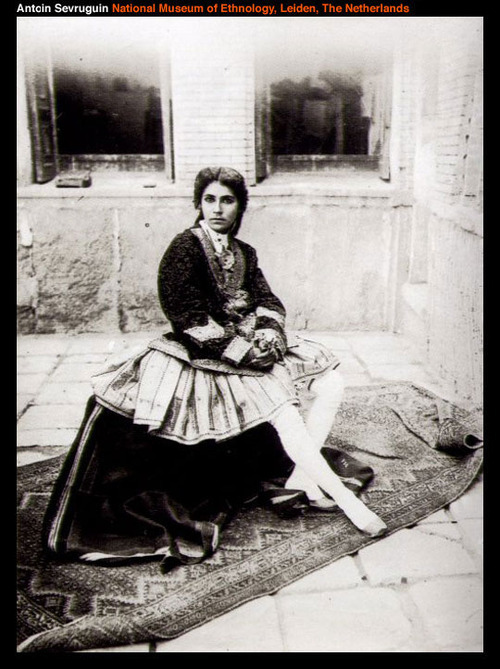An exhibition on Qajar beauty is on in Qatar at the moment, including some splendid photos as well as paintings.

The Qajar period was a time when ideals of feminine beauty changed greatly. Elsewhere on my website, I’ve shown how Qajar Bakhtiari women (top left image) were thought beautiful if they had a moon face, at least a slight moustache, and were fat enough so that if you poured a glass of water over them when they were sitting naked on the floor, then not a drop of that water would touch the floor, since it would have been trapped in all the rolls of fat as it descended.
Women in Nasr al Din Shah’s imperial harem “used makeup to draw moustaches and connect their eyebrows” if they didn’t – by any mischance – have a thick monobrow (abru-ye peyvasteh).

But times were changing. It’s often said that after Nasr al Din visited Paris in 1873, he saw the ballerinas there in tutus and then insisted that his poor women should wear something similar.
But the Shah wasn’t only looking at the women. Paris was in ruins after the Franco-Prussian war of 1870-1871 and the Paris Commune of 1871, and Nasir al-Din Shah’s travelogue records “a bizarre tableau of a ruined city as seen through the eyes of a first-time tourist”. The Shah was especially unimpressed by Parisian toilet facilities – which I suspect were nothing to do with the destruction: “In the alleys and streets, every twenty steps they have built a column, not very tall, which has a hole inside. It’s for people’s urination. People stand up in front of each other, without any shame, [dick[sic]] in hand, peeing. The stink of urine is in all the alleyways.” By the time he visits the Tuileries (in ruins) and the Vendome Column (also in ruins), Nasir al-Din Shah is frustrated: “In sum, the city of Paris is without splendour, without chiefs, without nobles, and without a king; it’s obvious what a place without a king looks like.”
So, at least in his opinion, one does need a Shah!
Later on, after the Bakhtiari army invaded in 1909, Tehran too became a ‘place without a king’. I don’t think there was quite as much peeing in the streets but, like Nasr al Din Shah, Bakhtiari men changed their ideas about female beauty and dress. Click here to see one old-style (and very well educated and well-travelled) Bakhtiari lady: a powerful and traditionally sturdy Bibi third section down on the left – and a totally differently styled Bakhtiari woman: born of a Tehrani mother: third row down in the middle.
Bakhtiari girls traditionally married their father’s brothers sons to strengthen intra-family alliances as well as reducing tension over inheritances. Boy’s marriages were, in contrast, about “broadening alliances” – and made connections with other factions within the Bakhtiari. When the Bakhtiari Khans started meeting and marrying women in Tehran, then the traditional marriage pattern broke down, and the tribal confederation started to fall apart.
Love the picture of Lady playing a tar. Very tempted to go to Doha to see this and the rest of the wonderful Islamic art collection.
I do prefer the modern idea of beauty though…
I wish I could have seen this exhibition: http://www.opinion-internationale.com/en/2014/09/17/paris-exhibition-lets-you-peep-through-the-harems-of-persian-kings_29137.html
I love those brows and ‘staches!